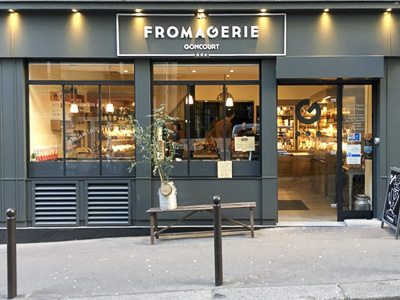Fromagerie Laurent Dubois
Apart from the time she spends in airports, Sue Sturman has my dream job. She oversees the English-language courses for Academie Opus Caseus, a French program that trains people for careers in cheese. One of the school’s offerings is a four-day “insider’s tour” of Paris cheese shops. The experience is for professionals only, but I figured Sue would give us a peek. If you’re headed to Paris (and isn’t everyone, eventually?), here’s what to know before you go:
Let’s talk about cheese-shop etiquette. Any do’s and don’ts for shoppers?
Don’t touch the cheese. There is almost never any self-service. Even if all you want is a carton of yogurt or a boxed Camembert, you don’t serve yourself.
Say hello when you go in and say thank you when you leave.
It is not the norm to offer tastings—perhaps because most French people have grown up with cheese and know what they’re looking for. Be circumspect about asking to taste. Be polite and deferential. “This is a cheese I don’t know. Might I taste it?” If they look at you funny, back down.
Apart from having more and better French cheeses, how does a Paris shop differ from an American one?
It will sell very little other than cheese. Shops are small so they can’t afford not to fill their shop with cheese, whereas we can’t afford to run a shop with just cheese. You might see some bottles of wine and a couple of little jam jars. Shops often sell bulk butter and crème fraîche. But you will never see bread because there’s a boulangerie on every corner.
A strong trend in Paris cheese shops now is the vente en avant (selling from in front). There’s no counter between you and the cheese. The cheese is arranged along the walls with open shelving. It saves a lot of space; some of these shops are tiny. The staff stands there with the customer in front of the cheese. Typically there’s a work table somewhere to cut and wrap on, or they have pullout shelves.
Do cheese shops specialize—like, in the cheeses of a particular region?
I haven’t seen that so much. But here’s an interesting bit of history. Until the beginning of the 20th century, there weren’t specialized cheese shops in Paris. There were butter/egg/cheese shops, and they had only local products. You wouldn’t even find alpine cheeses in Paris. Henri Androuët created the modern French cheese shop. He drove around France and sourced cheeses directly and united them in one Paris shop.
What you do see now is “house specialties”—different creations made from cheese. Everybody is doing truffled Camembert, halved along the equator and layered with truffles mixed with mascarpone. Or they’ll macerate Camembert in Calvados and coat it in breadcrumbs. Some make a sort of terrine of Gouda with dried fruits, or a blue cheese split and layered with membrillo.
When you take groups through these shops, what do they comment on?
How beautiful they are. The case setting is magnificent, like walking into a jewelry shop. There’s space between every cheese. The signage is clean, and there are no descriptions on the signs. That’s what the cheesemonger is there for. You lean on the expertise of the monger. It used to be that you’d never even know who the cheesemaker was unless it was a Camembert in a box. That was the deep secret that set one shop apart from the guy two blocks away. But just within the last handful of years they are starting to name producers.
How are the prices? Do the French spend as much as we do?
They don’t have to. It’s insane how little cheese costs there. Cantal is 27 euros a kilo (about $13.50 a pound); Morbier $21.25 a kilo (about $10.50 a pound); Camembert de Normandie 5.8 euros for the whole thing (about $6.50).
Do most Paris shops have a good selection of European cheeses? Do you see any American cheeses?
They will have Parmigiano-Reggiano, and most will have fresh mozzarella. Increasingly they’ll have Stilton and Gouda. But beyond that, not much. Fromager Beaufils has an interesting selection of international cheeses. The only American cheese that I’ve seen with any regularity is Rogue River Blue. American cheeses are prohibitively expensive by the time they get to France.
Fromagerie Taka & Vermo
If somebody has limited time, what’s the “don’t-miss” shop?
Classic: Quatrehomme. Modern: Laurent Dubois. And the giant food halls, like La Grande Épicerie in Au Bon Marché and Galeries Lafayette Gourmet. They’re like the old Macy’s Cellar but to the nth degree.
And the don’t-miss cheeses?
People have to taste a farmstead (fermier) Camembert de Normandie. And they should definitely taste a Munster. They should try some of the regional blues and a really ripe St. Nectaire. They should try a fresh Crottin de Chavignol, one that’s halfway hard, and one that’s really dry and hard. It’s one of the few cheeses that the French eat at different stages. Typically, there’s a peak ripeness for every cheese, but not for Crottin de Chavignol.
Crackers versus bread?
Bread always. Crackers they don’t even know from. You might have tiny ones, like Ritz Minis, when you’re having an aperitif, but crackers are not really in the French vocabulary. And they don’t eat fruit with their cheese.



